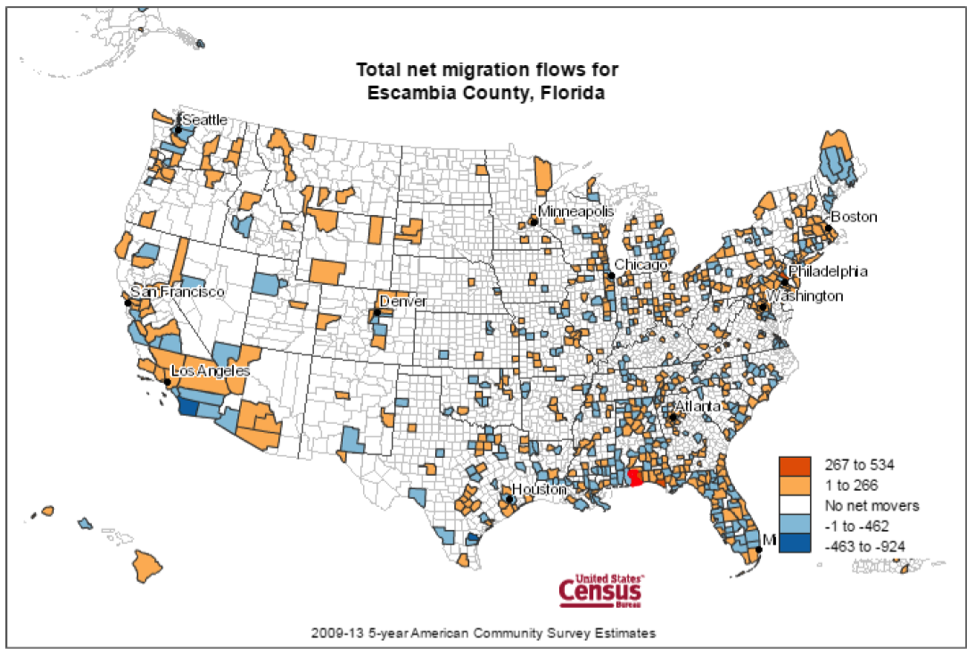Column: Escambia County struggles to retain high-income households
Phyllis Pooley, director of special projects for the University of West Florida Office of Economic Development and Engagement, shares her perspective on the migration of individuals and families into and out of Escambia County. Pooley has more than 15 years of experience working with demographic data.

By PHYLLIS POOLEY | ppooley@uwf.edu
Migration/geographic mobility refers to the movement of people from one location to another at various geographic levels. Population migration is a topic of interest to both the public and private sectors. Growth in a region is often dependent upon an area’s ability to attract and retain people. Economic factors, such as availability of employment, and local amenities, such as cultural attractions and weather, can play a role in migration decisions.
With its five-year datasets from the American Community Survey, the U.S. Census Bureau classifies movers by type of move (inbound or outbound), and characteristics of movers. Users of its Census Flow Mapper application can view the number of movers both in and out of an area as well as selected information about the movers, depending upon the dataset selected. While there are limitations to the data, due to a current inability to look at the same information over different time frames, the data that is available can provide potential insights into the demographics of new and former residents.
The community survey tracks where families and individuals go when they move from Escambia County. It also tracks where they come from when they relocate here. Top outbound locations for the 2009-13 time frame were Santa Rosa County; San Diego County, California; Nueces County, Texas; and Baldwin County, Alabama. Top inbound locations were Santa Rosa County; Duval County; San Diego County, California; and Baldwin County, Alabama.
More people move from Santa Rosa to Escambia than move from Escambia to Santa Rosa
In every time period currently available from the Census Bureau, movers from Santa Rosa County to Escambia County outnumber those moving from Escambia to its neighbor. These are just estimates, and the Census Bureau cautions against comparing overlapping time frames, but the data seem to suggest that this might be the case.
| 2009-13 | 2008-12 | 2007-11 | 2006-10 | |
| Santa Rosa to Escambia | 2,616 | 2,299 | 2,376 | 2,633 |
| Escambia to Santa Rosa | 2,082 | 2,280 | 2,263 | 2,647 |
Armed forces comings and goings represent approximately 18 percent of migration activity
Military installations have an effect on local migration patterns. During the 2008-12 time frame, the Census Bureau provided data for movers by employment in the armed forces. The number of inbound and outbound military movers (the number moving in minus the number moving out totals the “net mover”) represented about 18 percent of total movers in that time frame. The numbers do not always balance out; more people, for example, move from Escambia to San Diego and Corpus Christie than vice versa due to the normal advancement path of Navy flight training.
Escambia County may have a brain drain
In the 2007-11 time frame, the Census Bureau cross tabulated its migration estimates with the educational attainment of the inbound and outbound movers. Escambia County had negative net migration – more people moved out than moved in – at the higher degree levels.
| < High School | High School Graduate | Some College | Bachelor’s degree and above |
|
| Total IN | 1,170 | 1,665 | 2,606 | 1,194 |
| Total OUT | 1,105 | 1,941 | 2,959 | 2,143 |
| NET migration | 65 | -276 | -353 | -949 |
Escambia is not retaining high income households
Data from the 2008-12 community survey shows only one household income category – those that earn $35,500-$49,999 annually – having net positive migration. Loss of higher income individuals may also be reflected in the loss of those with higher levels of education.
| < $35,000 | $35- 49,999 |
$50- 74,999 |
$75-99,999 | $100-149,999 | $150,000+ | |
| Total IN | 2,628 | 1,919 | 1,670 | 762 | 598 | 626 |
| Total OUT | 3,429 | 1,279 | 2,264 | 1,651 | 1,364 | 761 |
| NET migration | -801 | 640 | -594 | -889 | -766 | -135 |
Escambia County attracts service, sales and military industry workers
In the 2008-12 time period, Escambia County showed positive net migration in occupations involved in the service industry, sales and office workers, and military-specific occupations. Given that this time frame encompasses the Great Recession, losses in construction and maintenance jobs are not surprising.
| Management, business, science, art | Production, transportation, material moving | Service | Natural resources, construction, maintenance | Sales and office | Military Specific Occupations | |
| Total IN | 2,390 | 944 | 2,657 | 1,720 | 2,090 | 3,420 |
| Total OUT | 3,015 | 1,699 | 2,129 | 2,453 | 1,964 | 2,068 |
| NET migration | -625 | -755 | 528 | -733 | 126 | 1,352 |
More variables are available in the Census Flows Mapper. As more migration data is released and cross tabulated by demographic characteristics, there will be opportunities for deeper analysis and stronger conclusions.



